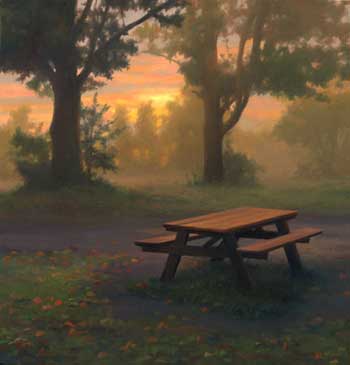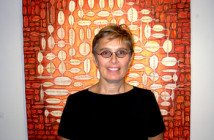Scott Prior: New Paintings
Alpha Gallery
14 Newbury Street
Through January 5
In the decades that I have attentively followed the work of the Northampton based, representational painter, Scott Prior, he now appears to be at the peak of form. The technique is ever more refined, subtle and nuanced in tonality and qualities of luminism. The subject matter, however, while richer and more passionately poignant, seems to be fixed in a time warp. His gallerist, Joanna Fink, laughed somewhat self consciously when the timeless quality of the gentle and nostalgic images of Prior’s wife and children were brought up in conversation.
We were surprised to learn that these new paintings were actually culled from old photographs. Hence the forever young sensibility of the children and the still nubile and perky, semi nude wife, their mother, Nanny, a skirt tied around her waist, but topless, wading with their “toddler” in a bucolic stream. Rather like a Constable summer day without the livestock.
It seems I have grown old with images of the nude Nanny. A classic from the series “Motel Room,” 1986, (from the Arthur Goldberg collection) was included in a traveling exhibition of portraits “Here’s Looking at You” that I organized in 1988.
Considering that work from nearly twenty years ago and paintings in the current exhibition is rather like watching grass grow. Which is the norm for artists who create in this manner. The increments of critical change are less about shifts of world view and subject matter than the intense and subtle enhancements of the brush. This field invites a kind of connoisseurship in which one would be quite challenged, at some time in the future, to attribute and date an unknown work. When, like some lost painting by Martin Johnson Heade, worth millions if proven to be authentic, it shows up at a yard sale decades or even centuries from now. One would have to know the work in depth, microscopically, to make such an authentication.
Joanna quipped that she discussed with Scott just that point of how confounded future art historians will be when dealing with the anachronisms of his family portraits. Perhaps, the artist is fixated with the kind of nostalgia and innocence of continuing to mine that fragile moment in time involving the youth and innocence of his maturing family. It is the corollary of teenage rebellion. In this case, the artist/parent who refuses to accept the age and progress of those delightful children and their perky breasted wife/ mother. It is an interesting alternative to the trend for nip and tuck.
How can we fault Prior when the results of this jugendstil is a visual and aesthetic delight? Within his genre Prior is surely only of the most satisfying of all contemporary artists. Admitting, obviously, that this is a narrow field with a limited audience. Which is true for his remarkable peers: The handful of artists of rural, red blooded, apolitical, life affirming Americana. No, you will not find their paintings in the various salons and biennials. They have been studiously neglected by the mavens of taste and trend. No critics and curators rest their reputations on works of such obvious quality. There is no need for arcane critical theory. No explaining and preaching necessary to the viewer or collector. These works just sell themselves to an eager but limited audience. Their dialogue is like that of the 19th century Barbizon school when compared to the tirades of urbane realists like Manet, Courbet and Daumier. There is no need for a strident argument in defense of images of country life. Those loving and simple images of Prior’s nude wife Nanny provoke no battles like those over Olympia.
Not to say that Prior is exclusively a painter of the figure. One of the most compelling images in this exhibition “Lake at Twilight” depicts a view of the cottage and porch on the left, clothes hanging on the line, backlit translucent light soaking through the laundry. It is the summer vacation that I remember from a childhood long ago.
Some of the most compelling pictures are quite small and simple such as the tiny, 6 x 6” “Pumpkin Field” as well as “Cow,” with a very puzzled and curious expression on its face, or the forlorn “Snowman.” My absolute favorite is the miniscule “Ezra Batman” with dark shadows cast from the pointy ears of the kids playing in Halloween costumes. He also has a long standing fixation with carnival sites and summer businesses during the off season.
The charm and riveting fascination of these images comes from that utopian vision of a childhood that has eluded most of us. My formative years seem more like the memory of the sled Rosebud consumed in the Valhalla of the family coal furnace in the final scene of “Citizen Kane.” Prior’s wonderful works allow for an alternative to that. He helps us to dream.
Kay Ruane: Lucid Dream
Miller Block Gallery
14 Newbury Street
Through December 23
Ironically, this exhibition of meticulously crafted, highly detailed, flawless pencil renderings by Kay Ruane “Lucid Dream” proves to be problematic. Clearly one may admire her technique. This is a very skilled artist. And surely there will be a strong audience response to that initial impact.
It is just that I don’t have much faith in the sentimental message of these highly detailed, small scale images. The common thread is a beautiful young woman, posed in such a manner as to avoid eye contact, surrounded by elaborate props in interior spaces. She is clothed in very feminine, gauzy, casual dresses. These pictures seem like illustrations for fashion or advertising.
In “Cupcake” we find a beautiful girl straddling a wing back chair side saddle. Her bare legs and feet thrust out to the right bracketing an elaborately rendered, carved, Chinese chest. To the left, on the floor, is a porcelain vase. Leaves of a large potted plant intrude into the left of the pictorial space. Through the window panes are views of a starry night. One hand adjusts a spaghetti shoulder strap that appears to have fallen down. With the other hand she holds a platter of Hostess cupcakes. The angle is the plate is precarious. Are the cupcakes about to slide off onto that meticulously rendered rug and gleaming wood floor? That would appear to be an impending disaster in this world of feminine perfection.
Just what is this perfect world all about? Do such women really exist? Is this a glimpse of the middle class interiors along Wisteria Lane in “Desperate Housewives.” Is this the lead up to a John Carpenter moment? The feminine calm before the storm. Do these women ever suffer from PMS? I have never known such women or not for very long.
Jill Slosburg-Ackerman
Judy Ann Goldman Fine Art
14 Newbury Street
Through January 9
This artist is known for combining organic, carved, grooved and sanded elements in juxtaposition with commercially created shelving and office furniture. In this exhibition the carvings, which have largely amoebic forms, dangle from or cling to the bottoms of shelves. They grow into and around things.
In the most ambitious piece “Yellow Lesson” the work combines wood, Plexiglass and a found object, a simple, geometric, chrome plated metal table. The table form is boxy and generic. The top is penetrated by a plexi cube that rests on a shelf below the top which it projects above. Extending from the top of this plinth is a branch of wood that resembles a large elephant tusk and has been elaborately carved into. Not with a Chinese scene or landscape, but a series of cavities as if produced by termites or some other wood ingesting insect.
The works look not so much created but evolved by some process of nature. Like the jungle reclaiming an abandoned man made structure. This conflict and resolution of the organic and inorganic implies an epic struggle. But the subtext is purely non objective. Unless you choose to make something out of it.
Links:
Alpha Gallery
Miller Block Gallery
Judy Ann Goldman Fine Art
All images are courtesy of the respective venues.
Charles Giuliano is a Boston based artist, curator and critic. He is a contributor to Nyartsmagazine, and the director of exhibitions for The New England School of Art & Design at Suffolk University. He periodically sends his column "Maverick Arts" via email, and Big Red & Shiny is proud to reprint it here.




